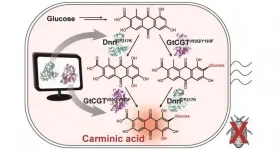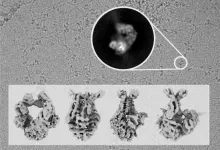Microbial production of a natural red colorant carminic acid
Metabolic engineering and computer-simulated enzyme engineering led to the production of carminic acid, a natural red colorant, from bacteria for the first time
2021-04-06
(Press-News.org) A research group at KAIST has engineered a bacterium capable of producing a natural red colorant, carminic acid, which is widely used for food and cosmetics. The research team reported the complete biosynthesis of carminic acid from glucose in engineered Escherichia coli. The strategies will be useful for the design and construction of biosynthetic pathways involving unknown enzymes and consequently the production of diverse industrially important natural products for the food, pharmaceutical, and cosmetic industries.
Carminic acid is a natural red colorant widely being used for products such as strawberry milk and lipstick. However, carminic acid has been produced by farming cochineals, a scale insect which only grows in the region around Peru and Canary Islands, followed by complicated multi-step purification processes. Moreover, carminic acid often contains protein contaminants that cause allergies so many people are unwilling to consume products made of insect-driven colorants. On that account, manufacturers around the world are using alternative red colorants despite the fact that carminic acid is one of the most stable natural red colorants.
These challenges inspired the metabolic engineering research group at KAIST to address this issue. Its members include postdoctoral researchers Dongsoo Yang and Woo Dae Jang, and Distinguished Professor Sang Yup Lee of the Department of Chemical and Biomolecular Engineering. This study entitled "Production of carminic acid by metabolically engineered Escherichia coli" was published online in the Journal of the American Chemical Society (JACS) on April 2.
This research reports for the first time the development of a bacterial strain capable of producing carminic acid from glucose via metabolic engineering and computer simulation-assisted enzyme engineering. The research group optimized the type II polyketide synthase machinery to efficiently produce the precursor of carminic acid, flavokermesic acid.
Since the enzymes responsible for the remaining two reactions were neither discovered nor functional, biochemical reaction analysis was performed to identify enzymes that can convert flavokermesic acid into carminic acid. Then, homology modeling and docking simulations were performed to enhance the activities of the two identified enzymes. The team could confirm that the final engineered strain could produce carminic acid directly from glucose. The C-glucosyltransferase developed in this study was found to be generally applicable for other natural products as showcased by the successful production of an additional product, aloesin, which is found in aloe leaves.
"The most important part of this research is that unknown enzymes for the production of target natural products were identified and improved by biochemical reaction analyses and computer simulation-assisted enzyme engineering," says Dr. Dongsoo Yang. He explained the development of a generally applicable C-glucosyltransferase is also useful since C-glucosylation is a relatively unexplored reaction in bacteria including Escherichia coli. Using the C-glucosyltransferase developed in this study, both carminic acid and aloesin were successfully produced from glucose.
"A sustainable and insect-free method of producing carminic acid was achieved for the first time in this study. Unknown or inefficient enzymes have always been a major problem in natural product biosynthesis, and here we suggest one effective solution for solving this problem. As maintaining good health in the aging society is becoming increasingly important, we expect that the technology and strategies developed here will play pivotal roles in producing other valuable natural products of medical or nutritional importance," said Distinguished Professor Sang Yup Lee.
INFORMATION:
This work was supported by the Technology Development Program to Solve Climate Changes on Systems Metabolic Engineering for Biorefineries of the Ministry of Science and ICT (MSIT) through the National Research Foundation (NRF) of Korea and the KAIST Cross-Generation Collaborative Lab project; Sang Yup Lee and Dongsoo Yang were also supported by Novo Nordisk Foundation in Denmark.
-About KAIST
KAIST is the first and top science and technology university in Korea. KAIST was established in 1971 by the Korean government to educate scientists and engineers committed to the industrialization and economic growth of Korea.
Since then, KAIST and its 64,739 graduates have been the gateway to advanced science and technology, innovation, and entrepreneurship. KAIST has emerged as one of the most innovative universities with more than 10,000 students enrolled in five colleges and seven schools including 1,039 international students from 90 countries.
On the precipice of its semi-centennial anniversary in 2021, KAIST continues to strive to make the world better through the pursuit in education, research, entrepreneurship, and globalization.
[Attachments] See images for this press release:

ELSE PRESS RELEASES FROM THIS DATE:
2021-04-06
El Niño-Southern Oscillation (ENSO) is one of the most prominent ocean-atmosphere interactions that varies year-to-year. This process exerts significant impacts on global weather and climate. El Niño is the warm phase of ENSO, which can be strong, moderate, or even weak. Within the past four decades, climatologists observed three super El Niño events (1982/83, 1997/98 and 2015/16). These extreme phases impacted global climate far more than moderate or weak events.
El Niño has a profound effect on the Madden-Julian Oscillation (MJO), which ...
2021-04-06
Metamaterials that can control the refractive direction of light or absorb it to enable invisible cloaks are gaining attention. Recently, a research team at POSTECH has designed a metasurface that can control the acoustic or elastic waves. It is gaining attention as it can be used to escape from threatening earthquakes or build submarines untraceable to SONAR.
Professor Junsuk Rho of POSTECH's departments of mechanical engineering and chemical engineering and Ph.D. candidate Dongwoo Lee of the Department of Mechanical Engineering in collaboration with Professor Jensen Li of HKUST have designed an artificial structure that can control not only the domain of underwater sound but also of vibration. The research team has presented an ...
2021-04-06
Scientists from the Genomic Integrity and Structural Biology Group led by Rafael Fernández-Leiro at the Spanish National Cancer Research Centre (CNIO) have discovered how certain proteins ensure the repair of errors introduced into the DNA during its replication. Using cryo-electron microscopy, they made the MutS protein, also known as the guardian of our genome, visible. That enabled them to describe how this single protein is able to coordinate the essential DNA repair process from beginning to end.
The study was carried out in collaboration with Meindert Lamers of the Leiden University Medical Center (LUMC, The Netherlands) and Titia Sixma of the Netherlands Cancer Institute and the Oncode Institute. Their results are published ...
2021-04-06
Eating together as a family, maintaining the Mediterranean diet's traditional customs of conviviality, influences the eating habits of adolescents and prevents eating behaviour disorders, according to a new study prepared by scientists from the Universitat Oberta de Catalunya (UOC) and the Universitat Autònoma de Barcelona (UAB) and published in the open access International Journal of Environmental Research and Public Health.
"At a time when lockdown due to the pandemic has revived family meals, this study indicates one of the possible positive aspects of the situation that we have had to confront", explains the study's researcher Anna Bach-Faig from the Foodlab group, and a member of the Faculty of Health Sciences.
The research establishes ...
2021-04-06
The period with the strictest lockdown conditions and quarantining posed additional problems for young people with autism spectrum disorder (ASD) and their families, given that their routines were suddenly disrupted. Routines form an essential aspect of their everyday life and life structure. However, their response and adaptation to this new situation was better than expected in aspects like communication and interaction with their families.
A study conducted by researchers from the Universitat Oberta de Catalunya, the University of Perugia and the ABAULA Occupational ...
2021-04-06
Lakes act as an important part of the earth system. They have special functions in regulating regional climate and maintaining regional ecological balance. More than 39.2% of the lakes in China are distributed in the plateau. The topography around the plateau lake area is complex and diverse. It leads to a complex and unique local circulation characterized by the superposition of lake-land breeze circulation and mountain-valley breeze circulation, which has a significant impact on the local energy and material circulation, according to Prof. Huizhi Liu, researcher at the Institute of Atmospheric ...
2021-04-06
Scientists from Tohoku University have developed a new fluorine-free calcium (Ca) electrolyte based on a hydrogen (monocarborane) cluster that could potentially realize rechargeable Ca batteries.
The researchers say the new material, achieved by designing the coordination structure of Ca cation with a weakly coordinating anion and mixed solvents, shows markedly improved electrochemical performances such as high conductivity and high electrochemical stabilities.
Current lithium-ion (Li-ion) batteries have some drawbacks. They are approaching their demand limits of theoretical energy ...
2021-04-06
Making the Case for Adjusting Quality Measures for Social Risk Factors
Henry Ford Health System-led report says adjustments would enhance quality.
DETROIT (April 5, 2021) - A new analysis by a team of researchers led by Dr. David Nerenz of Henry Ford Health System suggests that accounting for social risk factors like poverty, housing instability and transportation insecurity can have meaningful impact on healthcare quality measures without compromising quality of care.
In a report published today in Health Affairs, researchers make the case for using social risk factors in specific circumstances to "level the playing field" for adjusting quality measures used in quality reporting and value-based purchasing programs. Social risk adjustment ...
2021-04-06
CORVALLIS, Ore. - At a time when lumber prices are skyrocketing, an Oregon State University researcher has developed a new way to predict the future price of logs that uses readily accessible economic information.
"Log prices are really variable," said Jeff Reimer, a professor of applied economics at Oregon State. "That makes this a difficult business, whether you are land manager, mill owner, timberland investor or, as we are seeing now, a home builder."
The timber industry is critical to the economy of many regions of the world, including the Pacific Northwest. The health of the timber industry can be measured in various ways, including harvest levels, ...
2021-04-06
TUCSON, Ariz., April 6, 2021 - Dry periods between rainstorms have become longer and annual rainfall has become more erratic across most of the western United States during the past 50 years, according to a new study published by the U.S. Department of Agriculture's Agricultural Research Service and the University of Arizona
Against the backdrop of steadily warming temperatures and decreasing total yearly rainfall, rain has been falling in fewer and sometimes larger storms, with longer dry intervals between. Total yearly rainfall has decreased by an average of four inches over the last half century, while the longest dry period in each year increased from 20 to 32 days across the West, explained ...
LAST 30 PRESS RELEASES:
[Press-News.org] Microbial production of a natural red colorant carminic acid
Metabolic engineering and computer-simulated enzyme engineering led to the production of carminic acid, a natural red colorant, from bacteria for the first time








